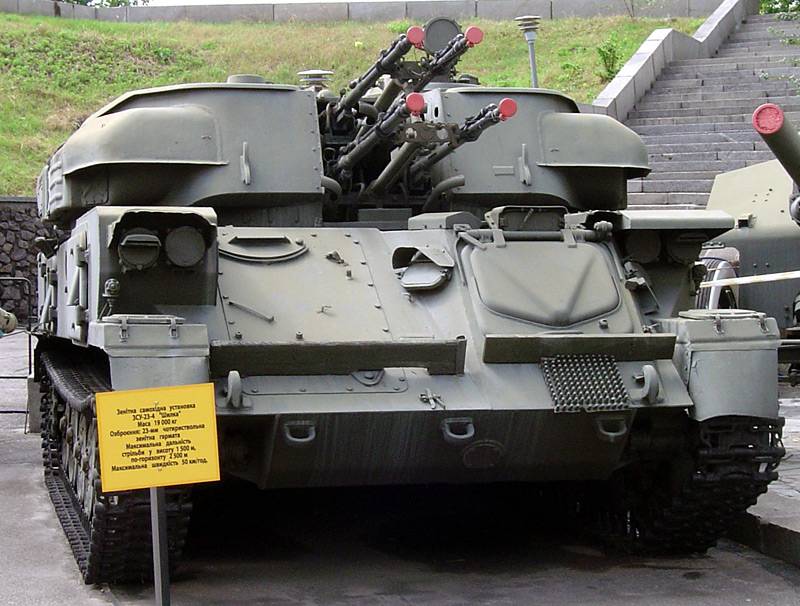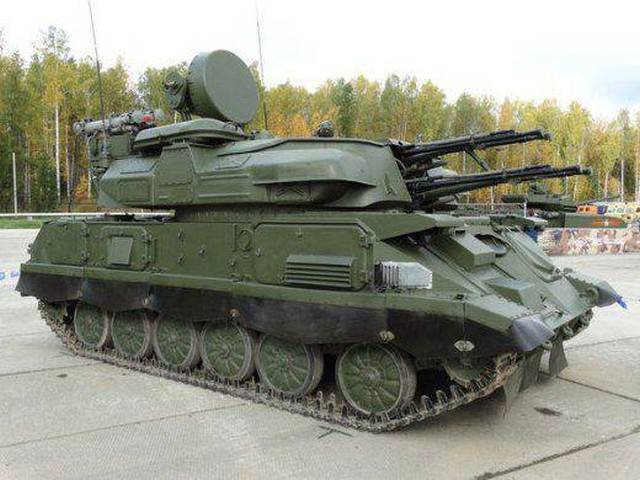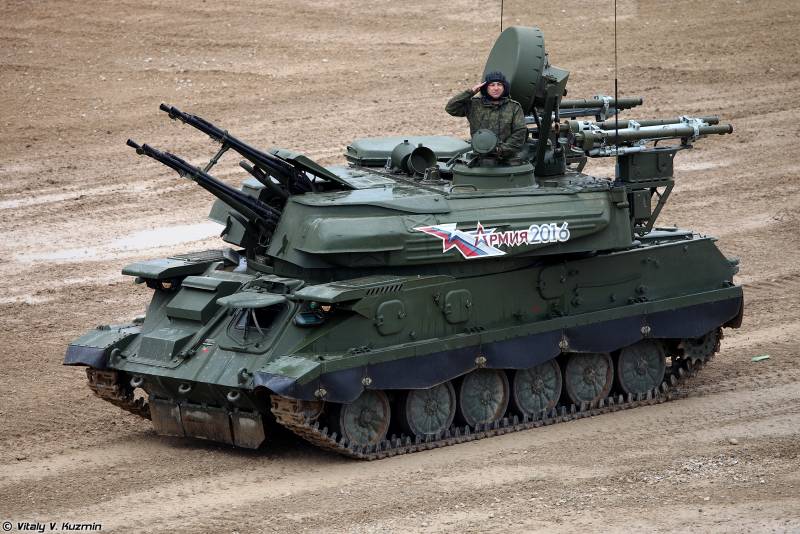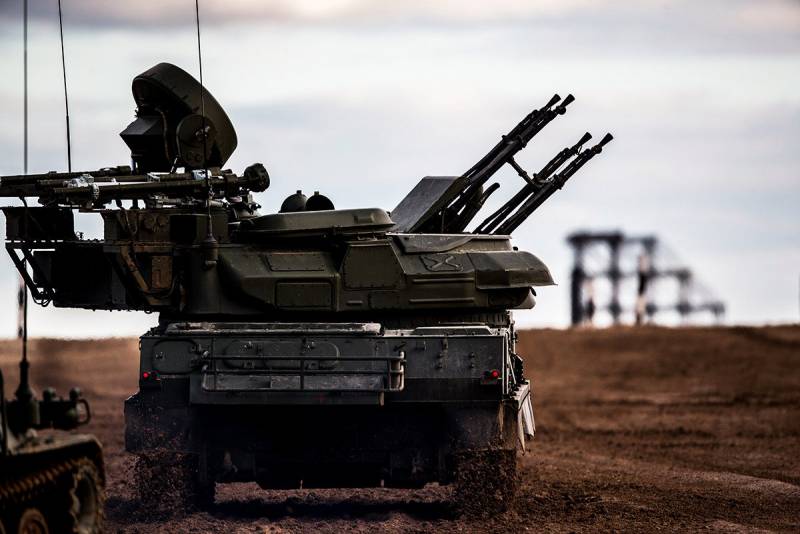The second life of "Shilka". New modification: "Shilka-M4"
Despite the fact that the Shilka serial production of the ZSU-23-4, named after the river, the left tributary of the Amur, was discontinued in 1982, modernizations of this installation continue to appear today not only in Russia, but also in other countries Poland, Ukraine, and the ZSU itself is still in service with the ground forces of the Russian Federation.
ZSU-23-4 "Shilka" (GRAU index 2А6) is a Soviet self-propelled anti-aircraft gun designed to directly cover ground forces, defeat various low-flying air targets (helicopters, airplanes, UAVs, cruise missiles), as well as ground (surface) targets as fire from the spot, and when shooting from short stops or in motion. The complex was developed by the famous Pribobystroy Design Bureau from the city of Tula, and by the production of the UMP, the Ulyanovsk Mechanical Plant, which today is part of the Concern VKO Almaz-Antey. The company is engaged in the modernization of the ZSU-23-4 Shilka at the present time. In the Soviet Union, this ZSU was part of the air defense units of the ground forces of the regimental level. Serial production of the installation, which was armed with a quad automatic 23-mm cannon with a rate of fire of 3400 rounds per minute, began in the 1964 year and lasted until the 1982 year. In total, about 6,5 thousands of ZSUs of this type were collected during this time.
Virtually none of the military conflicts of the second half of the 20th century did not go without the use of this combat vehicle. "Shilka" participated in the battles on the territory of Vietnam, where it was quite a serious threat to American pilots. It was actively used in the Arab-Israeli wars, the civil war in Angola, in the Libyan-Egyptian conflict, the Iran-Iraq and Ethiopian-Somali wars, in the fighting in the Balkans and in the Persian Gulf. The USSR widely used ZSU data during the war in Afghanistan. In Afghanistan, "Shilka" was used not as an air defense system, but as an infantry support fighting vehicle, inducing real horror to the souls. For the colossal combat power of four twin automatic guns, which have a huge rate of fire, the Afghan Mujahideen have nicknamed “Shilka” - “Shaitan-Arba” - devil's cart. In the absence of a real threat from the air, the installation was used to fire at various ground targets, including lightly armored ones, at a distance of 2-2,5 km it could easily suppress any enemy fortifications with fire.

At the same time, "Shilka" remains in demand in the XNUMXst century. This ZSU is actively used in a military conflict in Syria. Here it is also used as a fire support vehicle, which covers the action of attacking infantry units and tanks. With dense fire of quick-firing guns, the installation destroys machine gunners, snipers and grenade throwers of the enemy. This installation is especially effective in the conduct of hostilities in a dense urban area. The lifting angle of the automatic 23 mm guns is 85 degrees, which makes it easy to suppress the positions of militants located even on the upper floors of buildings. According to military experts, no large-scale army operation has been carried out recently in Syria without the participation of ZSU-23-4.
The quad automatic 23-mm gun, possessing high rate of fire and high initial velocity of the projectiles, is able to create a real "sea" of fire. Therefore, even a tank that falls under its fire can be taken out of combat, having lost almost all attached equipment and observation devices. Although modern anti-aircraft missile and air defense missile systems, which are available to the Russian Ground Forces, are superior to the Shilka in their parameters and characteristics, the main advantage of the ZSU is its ability to use it at the front line with direct contact with the enemy forces. Saves the presence of splinter and anti-bullet armor.
Until now, the installation ZSU-23-4 is in service with dozens of countries around the world, being an inexpensive, but at the same time universal means for solving various combat missions. At the same time, the appearance on the scene of new means of air attack and an increase in the pace of modern combat made it necessary to modernize the installation. Shilok is still used by hundreds in various armies of the world. At the same time, despite its already quite honorable age, there is often no alternative to them. Especially, taking into account the fact that not every state can afford to purchase new ZSU. Under these conditions, the task of modernizing a veteran machine only becomes more urgent.
Experts and military experts believe that one of the best options for upgrading and “modernizing” this combat vehicle is the Russian version of the Shilka-M23 ZSU-4-4М4. This version of the installation upgrade has been repeatedly demonstrated at exhibitions both in Nizhny Tagil and in the Patriot park near Moscow. The fire and running capabilities of the Shilka-M4 ZSU were also demonstrated in the framework of the Army-2018 International Military-Technical Forum at the Alabino training ground. According to the developers, the capabilities of the upgraded Shilka for air defense of ground forces units in all types of military operations and air defense of stationary objects have increased significantly.
ZSU-23-4М4 is an upgraded version of the installation with a new radar OMS (fire control system) and the possibility of installing the Sagittarius air defense missile system. The updating of the MSA is accompanied by the replacement of the existing radar with a newly created station of the same frequency range on a solid-state element base with an improved set of characteristics. The Sagittarius air defense missile system is designed to provide automated remote single, sequential launching of an Igla-type anti-aircraft system from a variety of land, sea or airborne carriers. When two or more Sagittarius combat modules are installed on the carrier, it becomes possible to launch salvo launches of two missiles at the same target, which significantly increases the chances of its being defeated. The placement of this complex actually turns the Shilka into a real anti-aircraft missile gun.
Also included in the battery of the complex was a PRNU, a mobile reconnaissance and control center “Assembly of M1” as a command post (CP) and a telecode communication channel for information exchange between the CP and ZSU. On board the upgraded machine, the analog calculating device was replaced with a modern digital computing system (DDS), and a digital tracking system is mounted. Has affected modernization and tracked chassis. Modernization of the chassis is aimed at improving the maneuverability and controllability of the self-propelled unit, as well as reducing the complexity of its operation and maintenance. The radio station and the active night vision device are also changing, replaced by a passive one. The upgraded version also installs an automated monitoring system for electronic equipment and air conditioning, which improves the working conditions of the crew, which is especially necessary in conditions of operation in a hot climate. The number of crews self-propelled remained unchanged - 4 person.
Having received as a part of the modernization, new equipment and equipment, Shilka-M4 retained its most important and proven over the years weapons - the quadruple 23-mm automatic gun 2А7М, which is easily guided in any direction along the azimuth with inclination / elevation angles from -4 to + 85 degrees. Effective shooting from this artillery mount is possible at a distance of 2-2,5 kilometers with an initial velocity of the 950-970 projectiles, m / s. The installation reach for height is 1,5 kilometers. This artillery installation can be effectively used to fire at flying targets moving at speeds up to 500 m / s. At the same time, with the use of Igla anti-aircraft missiles of the Strelets air defense missile (4 has such missiles on a combat vehicle), the target destruction range increases to 5 kilometers, and the height to 3,5 kilometers.
The standard Shkilka-M4 ZSU ammunition consists of 2000 23-mm shots and 4 Rocket Eagle. When operating in a single air defense system, the maximum detection range of air targets can reach 34 kilometers. The maximum range of tracking a radio channel is 10 kilometers, the minimum is 200 meters. The minimum height of tracking air targets radio channel is 20 meters. The consumption of shells per downed air target is estimated at 300-600 shots. The probability of hitting an air target in one span at an 300 shot rate is estimated at 0,5.
Unlike its predecessors, the Shilka-М4 modification is able to work in the conditions of difficult jamming conditions, and also to effectively detect air targets flying at low altitudes. Automation of the updated anti-aircraft complex independently adjusts for the wear of gun barrels and meteorological conditions, and also takes into account other factors affecting the trajectory of the projectiles and, as a consequence, the accuracy of fire. Simultaneously with the Shilka-M4 retrofit option, there is also an upgrade option for the ZSU-23-4М5, which is characterized by the presence of an optical-location channel in the control system that can guarantee the combat operation of the ZSU under conditions of strong interference with its radar. In the modernization project "Shilka-M5" it was also proposed to equip the combat vehicle with a laser rangefinder and an additional television viewfinder. The upgrades of the legendary Shilka ZSU currently being carried out provide the complex with a second life and the ability to remain in service with the Russian army and the armies of other countries for a long time.

ZSU-23-4М4 Shilka-М4
Information sources:
http://nvo.ng.ru/armament/2018-09-13/2_1013_fire.html
https://tvzvezda.ru/news/forces/content/201708080821-ynjz.htm
http://www.vestnik-rm.ru/news-4-13544.htm
Open source materials


Information